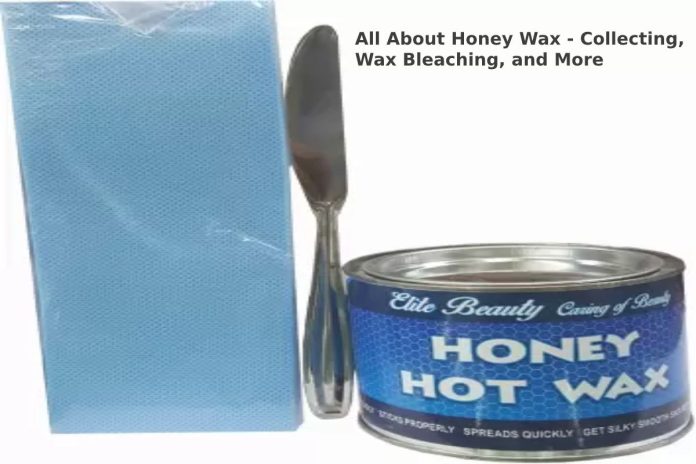Honey Wax
Honey wax It is the substance secreted by the ceriferous glands of young worker kinds of Honey. During the last stay in the hive, the pure Wax forms the walls of the cells in which the Honeys lay their eggs, raise their nymphs, and store Honey before becoming foragers, the glands of young kinds of honey finish forming. The four segments of the abdomen that are imbricated or superimposed show two transparent chitinous sheets called “wax plates” in their front part. How Wax is produce in the hive
Workers can secrete Wax more than once in their life. This Wax applies to Honey when they need to build combs to make the brood nest, seal the Honey and brood cells, and repair damage is feet in the swarm. His is roughly how Wax is produce in the hive, but the Honey keeper is much more interested in the Wax made by him, which to obtain better results will have to give it good treatment, which begins in the five itself. The secreted Wax is invariably white regardless of whether these kinds of Honey are fed sugar syrup or dark Honey. The color of different shades of yellow observed in the combs is due to the fat-soluble pigments of carotene that come from it. Pollen.
Also Read: Dry Shampoo – How to Use it? When to Use it? Best Dry Shampoos
Process of the Collecting Wax
There are many ways to process the Wax collected in the hives, but we will only explain the most important ones since the others can be study in any Honey keeping Activity Manual.
The Wax collected by the Honey keepers must be classified and stored in containers with separate lids so that in this way, a high-quality final product can be obtained. The classification of the Wax will be as follows:
- The Wax from caps, wedges, and new combs product of the breaks in the extraction of Honey.
- Clear Honeycomb wax and Wax from heads, frames, and caps scraping.
- Black Honeycombs and wedges with young.
Wax Bleaching
The Wax can be bleach, but in this process, part of its original aroma is a lot; it is for this reason that on many occasions, the Wax used to make candles is not subject to bleaching.
Different Methods of Bleach Wax:
- By action of the solar rays.
- We use chemical products, oxidizing agents such as Hydrogen Peroxide, Potassium Permanganate, Chlorine Compounds, and Dichromates.
- By absorption, they are adding diatomaceous earth or charcoal to the melted Wax.
Increase Wax Production in the Hive
For this, the colony must have a large contingent of young kinds of Honey. Young kinds of Honey from 10 to 18 days old are the ones with the best-developed cherry glands. Obtain a large intake of nectar or syrup essential in Wax’s production and stimulate the queen’s posture. A correct supply of quality pollen must accompany this entire process to catalyze the secretion of royal jelly and Wax, both necessary in this case.
Adulteration and Contamination of the Wax
The Wax is like a sponge that absorbs the toxins, poisons, acaricides, antibiotics, and other substances used, which leads to contamination with different types of diseases, as with other products that are detrimental to the subsistence of this laborious insect.
The primary pollutants in the Wax are the chemical products used by Honey keepers, while environmental pollution is much less critical. Other substances such as paradichlorobenzene used against the chick and some wood protectors also contaminate the Wax, such as:
- The number of drug treatments applied in the hive in recent years.
- Medicinal treatments are executed individually in an apiary.
- The representative wax sample of a hive should be taken from the brood chamber, as it is the one that was most expose to drugs.
Wax Properties
In addition to other components, the Wax is rich in vitamin A, and these components make the Wax have antibiotic, emollient, healing, and anti-inflammatory properties. It is mainly use as an excipient in the pharmaceutical industry. Wax is insoluble in water, slightly soluble in cold alcohol, soluble in ether, chloroform, carbon sulfide, and turpentine.
One of its first use was the manufacture of candles for lighting and religious purposes. The Honey keeping industry is a significant consumer to manufacture stamped wax sheets
In cosmetology, it is use to care for delicate skin, especially when it is dry. Cleanses the epidermis, softens and nourishes the dermis, thus preventing skin aging. White Wax is generally used to produce nourishing, astringent, cleansing creams and face masks. It is mainly use to prepare creams, ointments, plasters, lip crayons, cleansing, astringent lotions, and face masks. Beauty creams to prepare molds for dental prostheses and polishes, and many other pharmaceuticals, cosmetic, medical, and industrial uses. Other uses are in the manufacture of shoe ointments; in waterproofing materials; arms industry; polishes for floors; furniture, leathers and telescopic lenses, in the manufacture of fats, creams; in the manufacture of adhesive tapes, chewing gums, inks; in grafts and varnishes and also softens challenging tumors.
Sources
Borges Hidalgo, Daniel E. Specialists in European and Africanized Honeys. Production Director of the Cuban Honey keeping Company.
Also Read: How to have the Long Hair of your Dreams for your Wedding Day


















